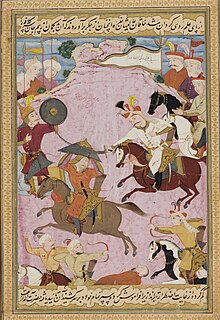Khanate of Bukhara
This article needs additional citations for verification. (June 2014) |
Khanate of Bukhara خانات بخارا | |||||||||||||||
|---|---|---|---|---|---|---|---|---|---|---|---|---|---|---|---|
| 1500–1785 | |||||||||||||||
|
War flag | |||||||||||||||
 The Khanate of Bukhara (green), c. 1600. | |||||||||||||||
| Capital | Bukhara | ||||||||||||||
| Common languages | Persian,[1][2] Uzbek | ||||||||||||||
| Religion | Islam (Sunni, Naqshbandi Sufism) | ||||||||||||||
| Government | Monarchy | ||||||||||||||
| Khan | |||||||||||||||
• 1500–1510 | Muhammad Shaybani | ||||||||||||||
• 1599–1605 | Baqi Muhammad Khan | ||||||||||||||
• 1747–1753 | Muhammad Rahim | ||||||||||||||
• 1758–1785 | Abu’l Ghazi Khan | ||||||||||||||
| Ataliq | |||||||||||||||
| Historical era | Early modern period | ||||||||||||||
• Establishment of Shaybanid dynasty | 1500 | ||||||||||||||
• Capture of Samarkand | 1505 | ||||||||||||||
• Establishment of Janid dynasty | 1599 | ||||||||||||||
• The khanate is conquered by Nader shah After Mohammad Hakim surrenders | 1745 | ||||||||||||||
• Manghit dynasty takes control after Nader shah dies and his empire breaks up | 1747 | ||||||||||||||
• Establishment of Emirate of Bukhara | 1785 | ||||||||||||||
| |||||||||||||||
| Today part of | |||||||||||||||
Khanate of Bukhara (or Khanate of Bukhoro) (Template:Lang-fa; Template:Lang-uz) was a Central Asian[4] state from the second quarter of 16th century to the late 18th century. Bukhara became the capital of the short-lived Shaybanid empire during the reign of Ubaydallah Khan (1533–1540). The khanate reached its greatest extent and influence under its penultimate Shaybanid ruler, the scholarly Abdullah Khan II (r. 1577–1598).
In the 17th and 18th centuries, the Khanate was ruled by the Janid Dynasty (Astrakhanids or Hashtarkhanids). They were the last Genghisid descendants to rule Bukhara. In 1740, it was conquered by Nadir Shah, the Shah of Iran. After his death in 1747, the khanate was controlled by the non-Genghisid descendants of the Uzbek emir Khudayar Bi, through the prime ministerial position of ataliq. In 1785, his descendent, Shah Murad, formalized the family's dynastic rule (Manghit dynasty), and the khanate became the Emirate of Bukhara.[5] The Manghits were non-Genghisid and took the Islamic title of Emir instead of Khan since their legitimacy was not based on descent from Genghis Khan.
Shaybanid Dynasty

The Shaybanid dynasty ruled the Khanate from 1500 to 1598. Under their rule, Bukhara became a center of arts and literature and educational reforms were introduced.
New books on history and geography were written in this period, such as Haft iqlīm (Seven Climates) by Amin Ahmad Razi, a native of Iran.[citation needed] Bukhara of the 16th century attracted skilled craftsman of calligraphy and miniature-paintings, such as Sultan Ah Maskhadi, Mahmud ibn Eshaq Shakibi, the theoretician in calligraphy and dervish Mahmud Buklian, Molana Mahmud Muzahheb, and Jelaleddin Yusuf.[citation needed] Among the famous poets and theologians who worked in Bukhara in that era were Mushfiki, Nizami Muamaya, and Mohammad Amin Zahed.[citation needed] Molana Abd-al Hakim was the most famous of the many physicians who practised in the Bukharan khanate in the 16th century.[citation needed]
Abd al-Aziz Khan (1540–1550) established a library "having no equal" the world over. The prominent scholar Sultan Mirak Munshi worked there from 1540. The gifted calligrapher Mir Abid Khusaini produced masterpieces of Nastaliq and Reihani script. He was a brilliant miniature-painter, master of encrustation, and was the librarian (kitabdar) of Bukhara's library.[6]
The Shaybanids instituted a number of measures to improve the khanate's system of public education. Each neighborhood mahalla — unit of local self-government — of Bukhara had a hedge school, while prosperous families provided home education to their children. Children started elementary education at the age of six. After two years they could be taken to madrasah. The course of education in madrasah consisted of three steps of seven years each. Hence, the whole course of education in madrasah lasted twenty-one years. The pupils studied theology, arithmetic, jurisprudence, logic, music, and poetry. This educational system had a positive influence upon the development and wide circulation of the Persian and Uzbek languages, and on the development of literature, science, art, and skills.[citation needed]
Janid Dynasty
The Janid Dynasty (descendents of Astrakhanids) ruled the Khanate from 1599 until 1747. Yar Muhammad and his family had escaped from Astrakhan after Astrakhan fell to Russians. He had a son named Jani Muhammad who had two sons named Baqi Muhammad and Vali Muhammad from his wife, who was the daughter of the last Shaybanid ruler.
List of rulers
- See Shaybanids.
- See Janids.
- Khanate of Bukhara breaks up into:
- See Manghits — (Emirate of Bukhara).
- See Yadigarids and later Qongirats — (Khanate of Khiva).
- See Minglars — (Khanate of Kokand).
Janids
- Baqi Muhammad Khan (1599–1605)
- Vali Muhammad Khan (1605–1611)
- Imam Quli Khan (1611–1642)
- Nadir Muhamma Khand (1642–1645)
- Abdul Aziz Khan (1645–1680)
- Subhan Quli Khan (1680–1702)[7][8][9]
- Ubaidullah Khan (1702–1711)
- Abu'l-Faiz Khan (1711–1747)
- ...
- Abu'l Ghazi Khan (1758–1785)
See also
Khanate of Bukhara.

References
- ^ Ira Marvin Lapidus - 2002, A history of Islamic societies, p.374
- ^ Dumper, Michael; Bruce E. Stanley (2007). Cities of the Middle East and North Africa: A Historical Encyclopedia. Santa Barbara: ABC-CLIO. p. 97. ISBN 9781576079195.
- ^ Vegetation Degradation in Central Asia Under the Impact of Human Activities, Nikolaĭ Gavrilovich Kharin, page 49, 2002
- ^ Gabriele Rasuly-Paleczek, Julia Katschnig (2005), European Society for Central Asian Studies. International Conference, p.31
- ^ Soucek, Svat. A History of Inner Asia (2000), p. 180.
- ^ Khasan Nisari. Muzahir al-Ahbab
- ^ László Karoly (14 November 2014). A Turkic Medical Treatise from Islamic Central Asia: A Critical Edition of a Seventeenth-Century Chagatay Work by Subḥān Qulï Khan. BRILL. pp. 5–. ISBN 978-90-04-28498-2.
- ^ Orvostörténeti Közlemények: Communicationes de historia artis medicinae. Könyvtár. 2006. p. 52.
- ^ Nil Sarı; International Society of the History of Medicine (2005). Otuz Sekizinci Uluslararası Tıp Tarihi Kongresi Bildiri Kitabı, 1-6 Eylül 2002. Türk Tarih Kurumu. p. 845.


